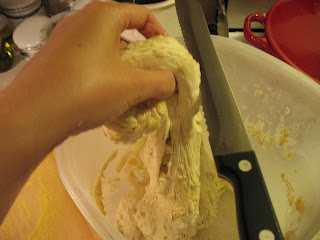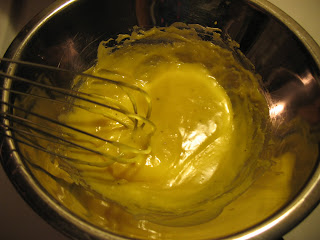
"...My salad days, / When I was green in judgment, cold in blood..."
-Cleopatra, from Shakespeare’s Antony and Cleopatra
I’ve been eating really a lot of salad lately, and perhaps my judgment is greener than it once was. I don’t mean that quite the way Shakespeare implied, but in the sense of environmentally “green.” All my salad greens are organic and come from the CSA* to which we subscribe. Sometimes, Kermit the Frog was right, it’s not easy being green, but with this CSA subscription, it sure is bountiful…and tasty!
I rarely buy salad dressing anymore (although if I was going to see Cate, I’d certainly buy her favorite “dip”…I like it, too!) Part of the reason is that I’d rather make things for myself when I can (thus, a food blog). I also, however, prefer variety, and to have a bottle of dressing for every mood would require a second refrigerator.
Besides, salad dressing is easy. You can make just enough to dress the salad you’re about to serve, or enough for a few days that you can keep on stand-by in the refrigerator. A whisk and a bowl are my favorite tools for blending ingredients, but you can use a small jar with a tight-fitting lid and shake the dressing to your heart’s content. For larger batches of dressing, you can even use a blender…if you don’t mind cleaning it when you’re done.

Below are four recipes for salad dressings that I’ve been making and eating during my salad daze. Three of them are designed for two servings and can be easily multiplied. The Buttermilk-Herb Dressing recipe serves four to five. I have included two vinaigrettes, a honey-mustard dressing, and my answer to ranch dressing, which I love. I must admit that I rarely measure ingredients for salad dressings, so the recipes are more like guidelines.
The Basic Vinaigrette can be varied to your personal taste. It is basically an acidic liquid and olive oil in equal portions with a few other flavorings. You can use just about any vinegar or citrus juice, and add herbs or spices to match the flavors of your meal or other salad ingredients. This is good on most green salads.
The Pomegranate Molasses Vinaigrette is the same dressing I used in the Simple Shredded Carrot Salad in the
Pomegranate Preference post. I just substituted walnut oil for the olive oil and added a touch of orange flower water for even more exotic flair. You certainly can leave out the orange flower water if you don’t happen to have any on hand (why wouldn’t you…I really am joking). I used this dressing on salad greens with fresh apricots, cherries, walnuts and shaved parmesan. I also think it would be good with other fruits like fresh berries later this summer, or apples and cranberries in the fall or oranges and pomegranate seeds in the winter.

The honey mustard dressing, like the basic vinaigrette, is good on just about any salad. You could probably change up the flavors by using different styles or flavors of mustard. Hmmm…I’ve got some cranberry mustard that might make things interesting.
The Buttermilk-Herb dressing is much thinner than commercial ranch dressings. I suppose you could add mayonnaise to it to thicken it up or even turn it into a dipping sauce (ie, for
grilled potatoes). I used
Organic Valley brand buttermilk, which I found to be less harsh in flavor than some other brands I’ve used.

If you start with these salad dressings and change the flavors to your taste, you can have seemingly endless salad varieties. I for one am hoping that my salad days go on for some more weeks and that my salad daze continues to be pleasant.
Basic VinaigretteYou can use just about any vinegar here and add herbs and spices to your taste.
2 tablespoons wine or cider vinegar or citrus juice, or a combination
1 tablespoon minced onion or shallot
1 large pinch each sugar and kosher salt
a few grinds of pepper from a peppermill
½ teaspoon Dijon mustard
2 tablespoons extra virgin olive oil
1. Combine the vinegar or citrus juice, onion or shallot, sugar, salt and pepper. Let stand for a few minutes or up to 15 minutes if you have time.
2. Add remaining ingredients and whisk until emulsified and very well combined (or shake in a jar with a tight-fitting lid).
Serves 2
Pomegranate Molasses VinaigretteThis is nice on green salads with fruit.
2 tablespoons pomegranate molasses
1 teaspoon honey
1 tablespoon lemon juice
pinch kosher salt
a few grinds of black pepper from a peppermill
1/8 teaspoon orange flower water (optional)
2 tablespoons walnut oil
1. Whisk together the pomegranate molasses, honey, lemon juice, orange flower water salt and pepper. Gradually add walnut oil, whisking until well combined.
Serves 2
Honey Mustard Salad Dressing1 tablespoon white wine vinegar
1 tablespoon minced onion or shallot
pinch of salt
a few grinds of black pepper from a peppermill
1 tablespoon honey
1 tablespoon Dijon mustard
2 tablespoons extra virgin olive oil
1. Combine vinegar, onion or shallot, salt and pepper. Let stand for a few minutes or up to 15 minutes if time allows.
2. Add honey and mustard. Whisk to combine. Add olive oil and whisk until well combined.
Serves 2
Buttermilk Herb Salad Dressing1 small garlic clove
½ teaspoon salt
¼ cup buttermilk
2 tablespoons half and half
1 tablespoon minced fresh dill
1 tablespoon minced fresh parsley
1 teaspoon lemon juice
2 tablespoons sour cream
¼ teaspoon black pepper
1. Finely chop the garlic. On the cutting board, add the salt to the garlic. Continue to chop, then make a paste by pressing and scraping the salt and garlic together with the flat side of the knife. Place the garlic paste in a small bowl.
2. Add the remaining ingredients the bowl and whisk well to combine.
Serves 4 to 5
*Community Supporte Agriculture
 A sure sign that you experienced 1980s popular culture is if you sing Dana Carvey's "Choppin' Broccoli" song from Saturday Night Live whenever you bring home a stalk of broccoli. I am so there! "My lady, she went down town....she bought some broccoli....she brought it hoooooome." Well, we got a lot of really, really nice broccoli in our CSA box this week, and I've been "choppin' broc-o-lay" to my heart's content.
A sure sign that you experienced 1980s popular culture is if you sing Dana Carvey's "Choppin' Broccoli" song from Saturday Night Live whenever you bring home a stalk of broccoli. I am so there! "My lady, she went down town....she bought some broccoli....she brought it hoooooome." Well, we got a lot of really, really nice broccoli in our CSA box this week, and I've been "choppin' broc-o-lay" to my heart's content.







































